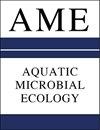北部湾球形褐囊藻华过程中的原核生物群落组成和结构
IF 1.1
4区 环境科学与生态学
Q3 ECOLOGY
引用次数: 2
摘要
近年来,球形褐囊藻华已成为中国北部湾的主要生态问题之一,对当地渔业和工业造成了一系列负面影响。虽然原核生物在藻华期间的营养循环和能量流动中起着关键作用,但有关原核生物群落在褐囊藻华期间的反应的信息仍然很少。因此,我们于2016年12月至2017年2月在该地区开展了一项全面的实地研究,涵盖了球形藻华的开始和衰老阶段。通过16S rRNA基因的高通量测序,揭示了其群落组成。从3132328个有效标签中共鉴定出7426个操作分类单元(OTUs),相似度为97%,其中Proteobacteria、Cyanobacteria、Thaumarchaeota、Verrucomicrobia、Euryarchaeota、Actinobacteria和Bacteroidetes为优势分类群。颗粒附着(PA)和游离(FL)原核生物群落的组成和结构存在显著差异:PA组分比FL组分更多样化,且在时间上不稳定。原核生物群落组成和结构的变化与主要环境变量密切相关,特别是溶解氧(DO)、NH4+、PO43-和溶解有机碳(DOC)。球形假单胞菌的存在可能导致原核生物群落的差异;Rhodobacteraceae、Alteromonadales、Porticoccaceae、Vibrio、Flavobacteriales和Verrucomicrobiae是球形假单胞菌爆发期和衰老期原核生物群落的关键类群。本研究为球形藻华过程中原核生物群落的响应提供了初步信息,为进一步研究热带海湾藻源有机物的生物地球化学过程提供了依据。本文章由计算机程序翻译,如有差异,请以英文原文为准。
Prokaryotic community composition and structure during Phaeocystis globosa blooms in the Beibu Gulf, China
Phaeocystis globosa blooms have become one of the major ecological issues in the Beibu Gulf, China, in recent years, resulting in a series of negative impacts on local fisheries and industry. While prokaryotes play key roles in nutrient cycling and energy flow during algal blooms, information regarding the response of the prokaryotic community during Phaeocystis blooms remains scarce. Thus, a comprehensive field study covering the onset and senescent phase of P. globosa blooms was conducted in the area from December 2016 to February 2017. The community composition was revealed with high-throughput sequencing of the 16S rRNA gene. A total of 7426 operational taxonomic units (OTUs) (97% similarity) were identified from 3132328 effective tags, with Proteobacteria, Cyanobacteria, Thaumarchaeota, Verrucomicrobia, Euryarchaeota, Actinobacteria, and Bacteroidetes being the predominant taxa. The composition and structure of particle-attached (PA) and free-living (FL) prokaryotic communities were significantly different: the PA fraction was more diverse and unstable temporally compared to the FL fraction. Variations in the composition and structure of the prokaryotic community were closely associated with major environmental variables, particularly dissolved oxygen (DO), NH4+, PO43-, and dissolved organic carbon (DOC). The presence of P. globosa may result in differences in the prokaryotic community; members of Rhodobacteraceae, Alteromonadales, Porticoccaceae, Vibrio, Flavobacteriales, and Verrucomicrobiae were the key taxa in the prokaryotic communities during the outbreak and senescent phases of P. globosa blooms. This study provides primary information on the response of prokaryotic communities during P. globosa blooms and will facilitate further study on biogeochemical processes of algal-derived organic matter in the tropical gulf.
求助全文
通过发布文献求助,成功后即可免费获取论文全文。
去求助
来源期刊

Aquatic Microbial Ecology
环境科学-海洋与淡水生物学
CiteScore
3.30
自引率
0.00%
发文量
8
审稿时长
3.0 months
期刊介绍:
AME is international and interdisciplinary. It presents rigorously refereed and carefully selected Research Articles, Reviews and Notes, as well as Comments/Reply Comments (for details see AME 27:209), Opinion Pieces (previously called ''As I See It'') and AME Specials. For details consult the Guidelines for Authors. Papers may be concerned with:
Tolerances and responses of microorganisms to variations in abiotic and biotic components of their environment; microbial life under extreme environmental conditions (climate, temperature, pressure, osmolarity, redox, etc.).
Role of aquatic microorganisms in the production, transformation and decomposition of organic matter; flow patterns of energy and matter as these pass through microorganisms; population dynamics; trophic interrelationships; modelling, both theoretical and via computer simulation, of individual microorganisms and microbial populations; biodiversity.
Absorption and transformation of inorganic material; synthesis and transformation of organic material (autotrophic and heterotrophic); non-genetic and genetic adaptation; behaviour; molecular microbial ecology; symbioses.
 求助内容:
求助内容: 应助结果提醒方式:
应助结果提醒方式:


